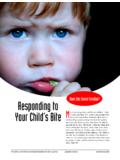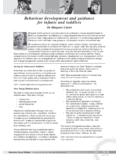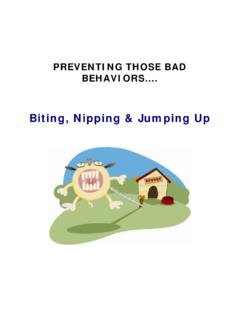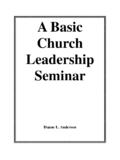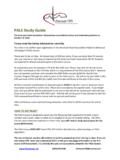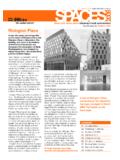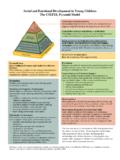Transcription of How and Why I Taught My Toddler to Read - Larry Sanger
1 How and Why I Taught My Toddler to read By Larry Sanger Version , revised December 14, 2010 Published online December 13, 2010 Downloadable at This essay is licensed under a Creative Commons Attribution-NonCommercial-NoDerivs Unported License. 2 How and Why I Taught My Toddler to read Table of Contents INTRODUCTION: WHY THIS ESSAY .. 3 ACKNOWLEDGMENTS .. 7 PART 1: HOW MY LITTLE BOY LEARNED TO read AS A Toddler .. 9 1. EARLY LITERACY ACTIVITIES .. 9 2. AN ECLECTIC METHOD OF TEACHING A SMALL CHILD TO read : SUMMARY .. 12 3. PHONICS FLASHCARD METHOD .. 18 4. YOUR BABY CAN read .. 25 5. READING BOOKS .. 28 6. CONCEPT-BUILDING: PRESENTATIONS, THE DOMAN METHOD, AND OPD.
2 35 7. OTHER EDUCATIONAL ACTIVITIES THAT HELPED WITH LEARNING TO read .. 40 8. PLANS FOR OUR SECOND CHILD .. 43 PART 2: TEACHING THE VERY YOUNG TO read A DEFENSE .. 45 1. YES, IT IS POSSIBLE .. 46 2. THE PROBLEM OF THE SALES HYPE .. 57 3. WHY ISN T THIS ALREADY COMMON KNOWLEDGE AND PRACTICE? .. 59 4. THE MARGINALIZATION OF VERY EARLY READING .. 63 5. THE PRESSURE OBJECTION .. 68 6. THE VICARIOUS ACHIEVEMENT WORRY .. 71 7. THE TOO-MUCH-VIDEO, TOO-EARLY OBJECTION .. 73 8. THE CREATIVE FREE PLAY OBJECTION .. 77 9. THE CONCEPTUAL MATURITY OBJECTION .. 84 10. THE SAPPED-MOTIVATION OBJECTION .. 92 11. THE MISEDUCATION OBJECTION .. 95 12. DOES EARLY READING REALLY HAVE LONG-TERM ADVANTAGES?
3 101 13. NO NEED TO BE DEFENSIVE .. 110 CONCLUSION .. 113 1. SOME TAKE-AWAYS .. 113 2. WHEN SHOULD WE START TEACHING OUR CHILDREN TO read , AND HOW? .. 119 3. THE IMPORTANCE OF SUPPORTING EARLY READERS IN SCHOOL .. 121 4. WHAT IS THE POINT? .. 125 BIBLIOGRAPHY .. 133 BOOKS AND ARTICLES .. 133 POPULAR ONLINE ARTICLES AND VIDEOS IN FAVOR OF VERY EARLY READING .. 136 POPULAR ONLINE ARTICLES AND VIDEOS CRITICAL OF VERY EARLY READING .. 136 OTHER POPULAR ONLINE ARTICLES .. 137 SOME BOOKS I read TO MY SON BEFORE HIS FOURTH BIRTHDAY .. 137 INDEX .. 139 Introduction: why this essay Can we teach our babies to read ? Yes. Should we? Probably. In this essay, I m going to try to convince parents that it is possible, and may be beneficial, to teach their children to read even while they are babies or toddlers.
4 I also have remarks for researchers throughout. First, I will explain how I Taught my own little one, beginning at age 22 months, and introduce some of our methods. Then I will answer various general objections to the notion and practice of teaching tiny tots to read . You might have heard of baby reading from the infomercials for Your Baby Can read (YBCR), or maybe an acquaintance bragged about her 3-year-old reading, or you saw some amazing videos on YouTube. But I m going to write this as if you had never even contemplated the idea of teaching such a young child how to read . The suggestion does sound admittedly bizarre at first.
5 You would probably be justified to dismiss it without a second thought, if it were not for stories like my little boy s. At 18 months old he knew most of the alphabet; a few months later, I decided to start teaching him to read , using certain methods; by 2 years old, he was reading at the first grade level; at 3 years 4 months, he was reading (or at least decoding) at the fourth grade level; and shortly before his fourth birthday, he sounded out the First Amendment of the Constitution. As evidence of this progress I submit this video. As I first publish this, in December 2010, he is and 4 How and Why I Taught My Toddler to read capable of decoding (not comprehending) some of my old philosophy books from college.
6 By now, many people have heard of YBCR. Fewer know that there has a been small movement to teach babies to read , since Glenn Doman published the first edition of How to Teach Your Baby to read in 1964. Doman has made a lot of claims either inspiring or extravagant, depending on your point of view about the potential of children. Regardless of the rhetoric, I m convinced that thousands of children have been Taught to read at surprisingly early ages by following his and similar methods. More recently, Robert Titzer discovered after making some videos for his baby daughter that she was able to recognize the words from the video even at the age of nine months.
7 Based on these videos he created YBCR, which again appear to have helped very many tiny tykes to learn to read . Whether they actually have done so is something I will discuss below in detail. But why write a long essay on this topic? I have three reasons. The first is that the phenomenon needs to be discussed in a way understandable to the public. I want to share what I ve learned with parents. With the YBCR phenomenon, and especially with all the YouTube videos of small children reading, I gather that there is a lively and growing interest in the whole notion of teaching very young children to read . But there is not very much objective information out there about the topic.
8 You can find blogs, articles (this set of pages from is excellent), and videos by people who are in business to sell baby-reading materials, and other comments from parents and child development students who are skeptical and disapproving of this movement. You can also find some quite critical essays online and book discussions from scholars in the fields of child development, psychology, and education. (See the Bibliography.) What is largely lacking, on both sides, is hard-nosed science or even very careful analysis. I will try to remedy these deficits by offering a very detailed case study and some in-depth discussion.
9 5 Introduction: why this essay I decided post this essay for free online. I ve done this sort of thing before, and it s one of the great things about the Internet: people just like to share their knowledge, especially when they perceive a need. I like the idea that I might help other people by what I write, and also that I might spark a deeper, better-informed discussion of the issues. The second reason is to intrigue psychologists, reading specialists, and other relevant experts with my own case study and with facts and arguments that they may have not considered. I would be delighted if this paper inspired some serious research into the issues raised here.
10 The third reason for the essay is to announce that, and explain why, I and the group of people behind are helping to arrange one of the first careful studies of the phenomenon of very early reading, and that I am, as of this writing, in the design stages of a large set of free multimedia reading tutors for very young children. A little about me and my background. I work from home and spend much of my free time helping to educate my first son, who is now 4 years old. Don t get me wrong, please he spends most of his day playing. But at mealtimes, bedtime, and occasionally at other times, I teach him stuff.
